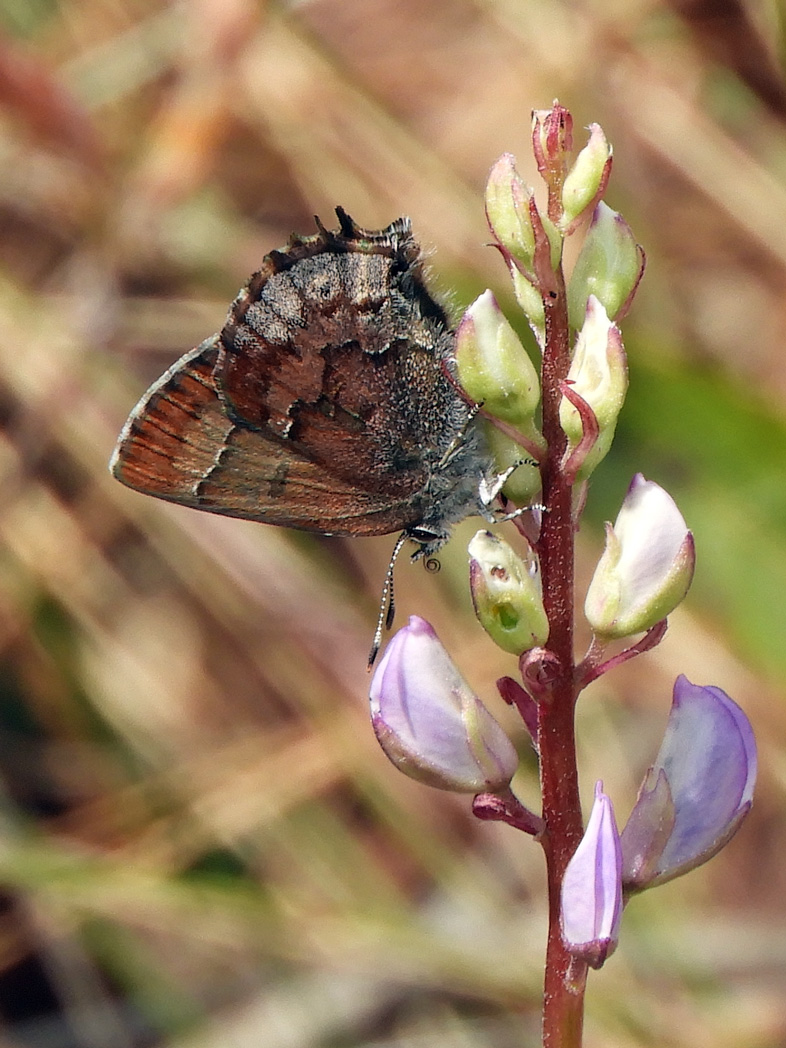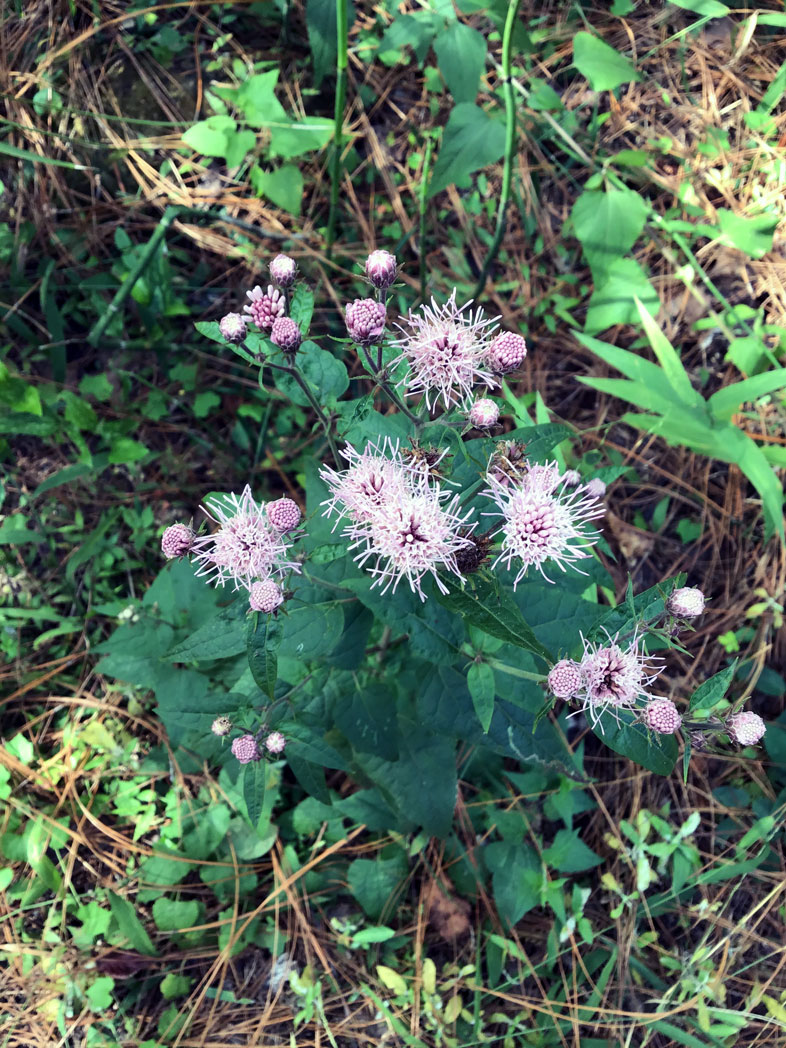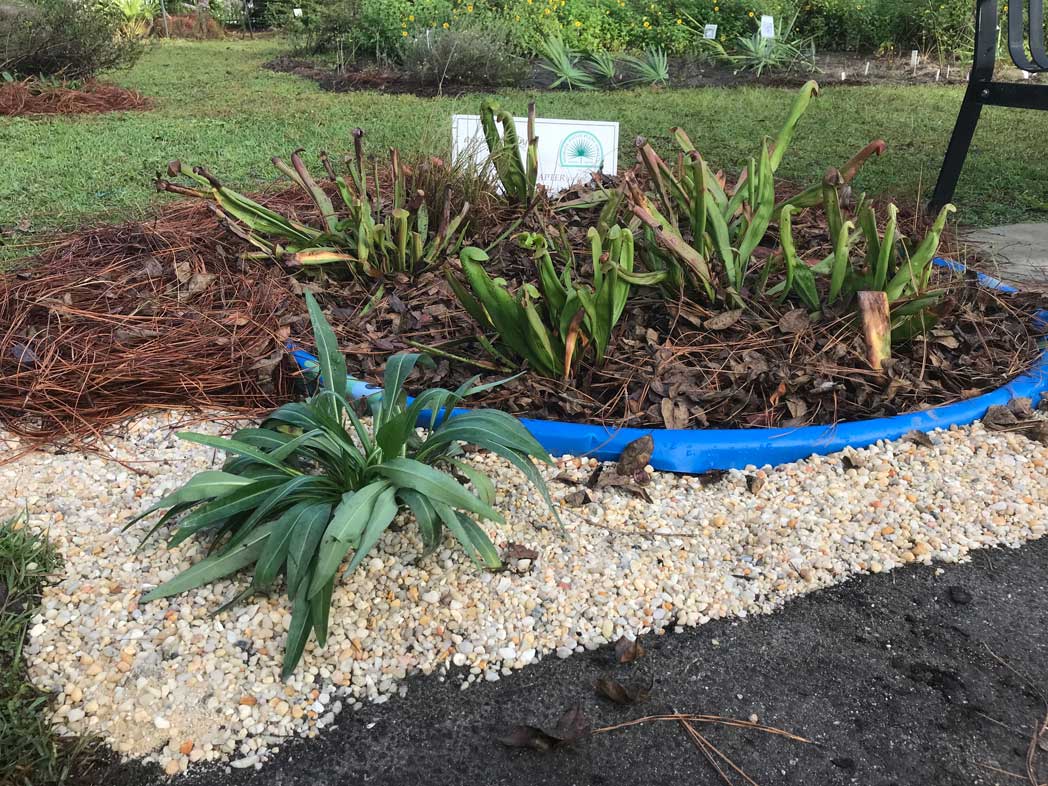Spring news from PWA counties
Lupine and Frosted elfin butterflies
Sally and Dean Jue, retired biologists coordinating with the U.S. Forest Service, are searching for the Frosted elfin butterfly (Callophrys irus) and its host plant, Sundial lupine (Lupinus perennis), in the sandhills of Apalachicola National Forest (ANF) near Tallahassee. They have been conducting research since 2008 to analyze the timing and frequency of prescribed fire and its effects on Lupines and the corresponding reproductive success of the Frosted elfin in adjacent burn compartments of the ANF. Geena Hill is doing research with Dean and Sally on behalf of Florida Natural Areas Inventory, seeking miniscule eggs on emerging Lupine. Geena is also the Florida Wildflower Foundation’s North Florida Wildflower Alliance liaison, coordinating volunteer efforts to save roadside wildflowers in the Florida Department of Transportation’s District 2.
You can help Florida Museum of Natural History researchers locate host plants as a community scientist by using iNaturalist. Florida plant hunters should look for Sundial lupine, especially in the Panhandle, and North Central Florida. Volunteers can log findings in a special iNaturalist projects page.

What’s Happening Around the Panhandle
Calhoun County
A small group of energetic volunteers recently met at the Blountstown Pollinator Garden to spruce it up for the upcoming North Florida Wildflower Festival on Saturday, April 24. Karen and Travis MacClendon, Scott Copeland, Charles Williams and a couple of his students from the local Future Farmers of America Chapter pitched in for a sunny morning of weeding and mulching. The Magnolia Chapter of the Native Plant Society and the Florida Wildflower Foundation will exhibit during the festival, while the MacClendons offer tours of the garden.
Gadsden County
by Mary Howard Edwards
Last October, the Gadsden County commission approved designating three segments of county highways as wildflower preservation areas. The areas were nominated in 2019 after Scott Copeland, Greg Jubinsky, Florida Wildflower Foundation (FWF) Research and Planting contractor Jeff Norcini and FWF Regional Wildflower Alliance Liaison Liz Sparks scouted roadsides for naturally occurring wildflowers. Signs are being made to mark Wildflower Areas before the Public Works department starts mowing. Roy Braswell, head of operations, visited the sites a few weeks ago so he could pass along information to his mowing crew. We also met with Bill and Cindy Piotrowski and residents of Sandy Creek Homeowners Association to discuss wildflower seeding along segments of the U.S. Highway 27 median. Hopefully by fall, Gadsden County will have some prettier roadsides and increased pollinator habitat.
Gulf County
Nancy Jones and Susan Wozniak, volunteers from the St. Joe Garden Club, met in mid-March to scout three roads for potential inclusion in the county’s wildflower program. They visited County Roads 386 and CR 387 and State Road 22 only to find silt fencing, heavy equipment and preparations underway to resurface the roads — not a good time to request conservation of roadside wildflowers. They will revisit the roads next year after the vegetation has time to recover.
Meanwhile, the Florida Department of Transportation is in contact with local officials to confirm its reduced-mowing request for Wildflower Areas on state roads following Hurricane Michael recovery.
Jackson County
The county has a full slate of local roads to add to its ambitious wildflower program, thanks to efforts of Christy Andreasen, head of the county’s Tourism Development Council. A group of wildflower advocates met Public Transportation Director Scotty Taylor and Rett Daniels of Public Works, who oversees management of Citizens Lodge, a popular public park. We were joined by Frances Stone, Chad Taylor and Lois Jones, local conservationists who shared a desire to see wildflowers restored at Citizens Lodge, where they once had been plentiful. It was gratifying to hear Scotty pledge to educate staff about the specifics of modified roadside mowing, beginning with Blue Springs Road leading to the newly restored Blue Springs Recreation Area. Local botanist Floyd Griffith has agreed to work with staff to identify and restore wildflower areas in select locations at the Lodge. It will be exciting to see a wildflower program develop in Jackson County!
Jefferson County
by Jennifer Mason
Wildflowers are making their annual big show now. Many folks notice the gaudy exotics and inquire about them first, but more and more, thanks to social media, gardeners are being educated by posts from botanists and enthusiasts all over the state. Spring ephemerals — such as violets, Trillium, Carolina jessamine (Gelsemium sempervirens), Trout lily (Erythronium spp.) and many others — are seen for a short and glorious period. Their habitats differ, but one thing is for certain: When you go creeping into the forest or wetland in search of these beauties, they may not be there next year.
Transition of many of our longstanding native favorites are gradually shifting away toward cooler ground. There is a seepage hillside in Jefferson County that was once covered in Bloodroot (Sanguinaria canadensis) and Solomon’s seal (Polygonatum biflorum), both spring ephemerals that are prevalent in the Smokey Mountains. There are practically none on that hill today, and the forest remains undisturbed. Some wildflowers are propagated by seed and are transient annuals, such as Dicerandra. Even so, you can find them again in bloom not far from where they bloomed last year. Many perennials are disappearing. You can see them still in abundance farther north.
If you find a rare beauty in the woods, you can use iNaturalist to help identify it. Using iNaturalist is a good way to share information with others, including scientists who can monitor shifts in the range of plant species.

About 30 years ago, I gathered some seed from Heartleaf bricklebush (Brickellia cordifolia) that was growing on the same hillside as the Bloodroot. I was successful in propagating it and now have a garden full of it that reliably comes up every year, both from seed and roots. It has spread to my neighbor’s property, and we are thrilled. When I went back to the original site on that hill to see it again many years later, it was gone. The shifting of plant populations is a natural occurrence, but I believe we are beginning to see a more rapid change.
Woody flowering shrubs such as azaleas (Rhododendron spp.), Virginia willow (Itea virginica), Viburnum and Lyonia species, and others appear to be stable and thriving. I have observed the same individuals in a large forest for decades now. My scope may be limited, but observation over time gives valuable information as to a changing climate.
Wakulla County
by Sandy Tedder
Florida Native Plant Society Sarracenia Chapter volunteers help at Depot Park in historic downtown Sopchoppy. In October 2020, there was a planning session for new plantings in the park for 15 to 20 species of native plants and trees. Also planned was a bog garden for Hooded pitcherplants (Sarracenia minor). On Nov. 7, in masked and socially distanced conditions, our team planted the majority of the pre-selected native species. One week later, with the welcome help of Mark Perrin preparing and digging the large area for the bog garden and Lynn Artz directing, we meticulously mixed our planting soil according to directions from pitcherplant expert Dr. Larry Mellichamp. Into the new bog we planted the pitcherplants and dewthreads and sundews (Drosera spp.) — all native carnivorous plants that feed on insects.

Winter was a bit rough on the pitcherplants, and they looked like a patchwork of brown and green stalks over the last few months. The dewthreads went dormant, but now there are little flower buds on one of the pitcherplants and some new Hooded pitcherplant shoots emerging. The dewthreads are unfurling and there are bloom stalks on the tiny sundews.
We wouldn’t have been able to accomplish this effort without the talented help of our coordinator Lynn, Sopchoppy Mayor Lara Edwards, landscaper Betsy Smith, and our team of planting volunteers — David Roddenberry, Jeannie Brodhead, Betsy Rudden, Pam Pafford, Sandy Tedder and George Boszilkov.
There is always a need for volunteer help to maintain and weed the park plantings or to set out new specimens or check water conditions, so if you would like to help, please contact us Sarracenia.nps@gmail.com.
Walton County

Wildflower Walton, a group of wildflower advocates, is enthusiastically embracing roadside wildflower conservation. We met virtually with staff from Public Works and requested a total of four segments along 12 miles of county roads for modified mowing management. Staff has requested information for the Board of County Commissioners meeting in April to seek approval of the proposed modifications. We are soliciting letters of support for the project. Please contact Liz Sparks at lsparks@flawildflowers.org for a template letter if you are willing to write one.
